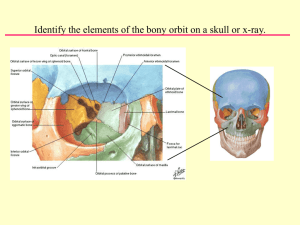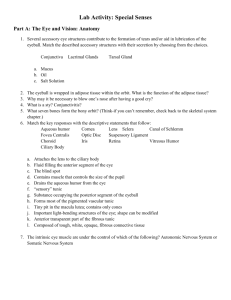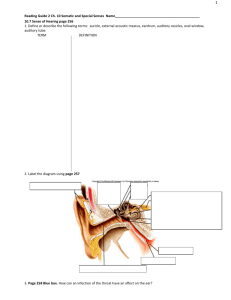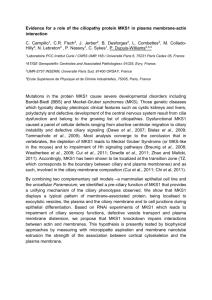Dissection 6
advertisement
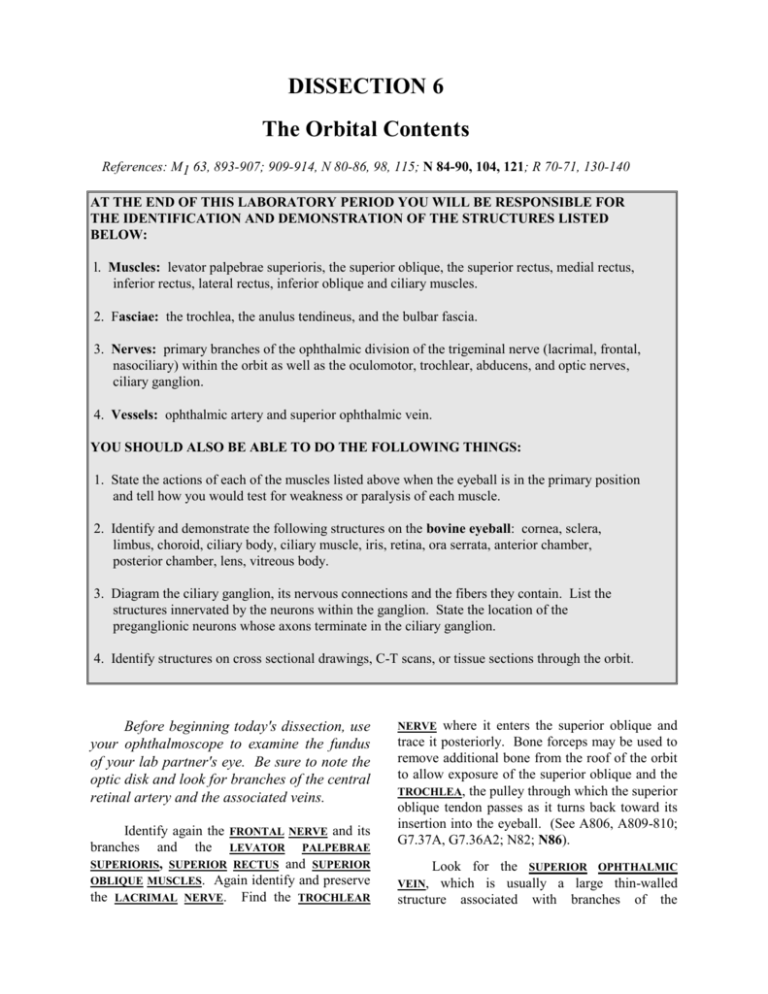
DISSECTION 6 The Orbital Contents References: M1 63, 893-907; 909-914, N 80-86, 98, 115; N 84-90, 104, 121; R 70-71, 130-140 AT THE END OF THIS LABORATORY PERIOD YOU WILL BE RESPONSIBLE FOR THE IDENTIFICATION AND DEMONSTRATION OF THE STRUCTURES LISTED BELOW: l. Muscles: levator palpebrae superioris, the superior oblique, the superior rectus, medial rectus, inferior rectus, lateral rectus, inferior oblique and ciliary muscles. 2. Fasciae: the trochlea, the anulus tendineus, and the bulbar fascia. 3. Nerves: primary branches of the ophthalmic division of the trigeminal nerve (lacrimal, frontal, nasociliary) within the orbit as well as the oculomotor, trochlear, abducens, and optic nerves, ciliary ganglion. 4. Vessels: ophthalmic artery and superior ophthalmic vein. YOU SHOULD ALSO BE ABLE TO DO THE FOLLOWING THINGS: 1. State the actions of each of the muscles listed above when the eyeball is in the primary position and tell how you would test for weakness or paralysis of each muscle. 2. Identify and demonstrate the following structures on the bovine eyeball: cornea, sclera, limbus, choroid, ciliary body, ciliary muscle, iris, retina, ora serrata, anterior chamber, posterior chamber, lens, vitreous body. 3. Diagram the ciliary ganglion, its nervous connections and the fibers they contain. List the structures innervated by the neurons within the ganglion. State the location of the preganglionic neurons whose axons terminate in the ciliary ganglion. 4. Identify structures on cross sectional drawings, C-T scans, or tissue sections through the orbit. Before beginning today's dissection, use your ophthalmoscope to examine the fundus of your lab partner's eye. Be sure to note the optic disk and look for branches of the central retinal artery and the associated veins. Identify again the FRONTAL NERVE and its branches and the LEVATOR PALPEBRAE SUPERIORIS, SUPERIOR RECTUS and SUPERIOR OBLIQUE MUSCLES. Again identify and preserve the LACRIMAL NERVE. Find the TROCHLEAR where it enters the superior oblique and trace it posteriorly. Bone forceps may be used to remove additional bone from the roof of the orbit to allow exposure of the superior oblique and the TROCHLEA, the pulley through which the superior oblique tendon passes as it turns back toward its insertion into the eyeball. (See A806, A809-810; G7.37A, G7.36A2; N82; N86). NERVE Look for the SUPERIOR OPHTHALMIC which is usually a large thin-walled structure associated with branches of the VEIN, Dissection 6, The Orbital Contents (A777; Gp647; N81; N85). The two vessels are found in relation to the superior oblique muscle in the anterior part of the orbit. In its course through the orbit the superior ophthalmic vein passes between the superior rectus and the OPTIC NERVE and exits from the orbit through the superior orbital fissure outside of the ANULUS TENDINEUS (of Zinn), which is the common tendinous origin of the four rectus muscles (G7.40A; A809, 815; N80; N84). OPHTHALMIC ARTERY Identify and clean the LATERAL RECTUS and its nerve, the ABDUCENS NERVE (A805; G7.36A; N82; N86). (Be careful not to disturb the orbital fat adjacent to the optic nerve which contains the short ciliary nerves and ciliary ganglion.) You may find it helpful as the dissection proceeds to cut the lateral rectus at its midpoint and to reflect the two parts of the muscle. As the anterior half of the lateral rectus is reflected toward the eyeball, note how it becomes ensheathed with fascia that is continuous with the BULBAR FASCIA on the eyeball. (G7.39A; A816; N83; N87) MUSCLE Look on the inferior surfaces of the levator palpebrae superioris and the superior rectus for their nerves, which are branches of the OCULOMOTOR NERVE. (A804; G7.36A; N82; N86) Ask your lab partner to look up. What happens to the upper lid? In addition to the eyelid what other structure is elevated as the pupil is turned upward? (See H818 and H33-21; 968; G7.39B). The Ciliary Ganglion In company with the ophthalmic artery and the superior ophthalmic vein is the NASOCILIARY NERVE (A805; G7.36A; N82; N86). Carefully dissect along this nerve looking for small hairlike branches which pass anteriorly to the back of the eyeball and to the ciliary ganglion. The CILIARY GANGLION is about the size of a pin head and is located just lateral to the optic nerve in the posterior half of the orbit. It may be found in three different ways by finding the nerves which connect it to other structures. Look at A804, 805, 807 or Gp649 or N82, N86 and note that the ciliary ganglion is connected to the nasociliary Page 2 nerve by the communicating branch just referred to. The ganglion is also connected with the inferior division of the oculomotor nerve. The latter connection may be found by following the branches of the oculomotor nerve innervating the superior rectus and levator palpebrae superioris back to the main trunk of the oculomotor nerve. Then identify the inferior branches of the nerve which supply the medial rectus, the inferior rectus and the inferior oblique. The oculomotor root of the ciliary ganglion comes from the branch to the inferior oblique muscle. Finally, there are a number of delicate filaments, the short ciliary nerves, which pass from the ganglion to the posterior surface of the sclera along the lateral aspect of the optic nerve. These nerves may be identified in the fat surrounding the optic nerve and traced back to the ganglion. Be sure that you know that the short ciliary nerves contain postganglionic parasympathetic fibers from nerve cells in the ciliary ganglion. These fibers supply the ciliary muscle (causing accommodation of the lens) and the sphincter pupillae. The oculomotor root of the ciliary ganglion contains preganglionic parasympathetic fibers from the nucleus of Edinger-Westphal. What other types of fibers are found in the short ciliary nerves? (See N115; N121) When the ciliary ganglion and its connections have been secured, remove the remaining orbital fat from the INFERIOR OBLIQUE, the INFERIOR RECTUS, and the MEDIAL RECTUS and demonstrate their insertions and their origins. Note that the inferior oblique can be best approached anteriorly by making a small incision in the lower eyelid near the floor of the orbit. Dissection of the Beef Eye Remove most of the fat, fascia, and muscles from the beef eye. Do not be concerned with the identification of the extraocular muscles, as the arrangement is quite different from the human eye. Carefully cut through the coats of the eyeball so as to separate them into anterior and posterior halves. Cut into the VITREOUS BODY as little as possible. Identify the SCLERA, the CHOROID, and the RETINA. The shiny greenish layer is the tapetum, a reflective layer not found in the human Dissection 6, The Orbital Contents Page 3 eye. Gently manipulate the vitreous body and the LENS to demonstrate the zonular fibers (suspensory ligament of the lens). Now, remove the CORNEA by making an incision at the LIMBUS, and push the IRIS and the CILIARY BODY away from the sclera. Note that the cavity of the eyeball in front of the lens is divided by the iris into an ANTERIOR CHAMBER and a POSTERIOR CHAMBER. The white line on the external surface of the ciliary body is the CILIARY MUSCLE (A817, 820) and the jagged peripheral margin is the ORA SERRATA. ____________________________________________________________________________________ STUDY QUESTIONS 1. Name the coats of the eyeball. 1. The outer fibrous coat, the middle vascular coat, and the retina. 2. What are the subdivisions of the fibrous coat? 2. The fibrous coat is made up of the cornea and sclera. 3. What are the subdivisions of the vascular coat (also called the uveal tract)? 3. The vascular coat is divided into the iris, the ciliary body, and the choroid. 4. What are the subdivisions of the retina? 4 The retina is divided into three parts corresponding to the parts of the vascular coat which they line. They are the iridial retina, the ciliary retina, and the pars optica of the retina. 5. What term is given to the anterior limit of the pars optica retinae? 5. The ora serrata. 6. Are the ciliary and iridial parts of the retina sensitive to light? 6. No. 7. Where is there smooth muscle in the eyeball? 7. The ciliary muscle in the ciliary body and the sphincter pupillae and the dilator pupillae muscles in the iris are smooth muscle. 8. What is the nerve supply to these muscles? 8. The ciliary muscle and the sphincter pupillae muscle are innervated by postganglionic efferent fibers from the ciliary ganglion. The dilator of the pupil is innervated by postganglionic fibers from the superior cervical ganglion. 9. Locate the cell bodies of the preganglionic fibers to the ciliary ganglion. 9. Nucleus of Edinger-Westphal. 10. How do these fibers reach the ciliary ganglion? 10. Through the oculomotor nerve and the motor root of the ciliary ganglion. Dissection 6, The Orbital Contents Page 4 11. Locate the cell bodies of the preganglionic fibers to the superior cervical ganglion. 11. Intermediolateral cell column of the upper thoracic spinal cord. 12. What other smooth muscle in the orbit is supplied by postganglionic fibers from the superior cervical ganglion? 12. The superior tarsal muscle in the upper lid. This is the smooth muscle part of the levator palpebrae superioris. 13. Draw and label a diagram showing the route taken by the aqueous humor from the point of its secretion until it leaves the anterior chamber. 13. 14. Trace the route of the circulation of the aqueous humor. 14. Secreted by the epithelium of the ciliary processes posterior chamber pupil anterior chamber trabecular meshwork canal of Schlemm. 15. What is glaucoma? 15. Glaucoma is a condition of increased intraocular pressure leading to optic nerve damage and defects in the visual fields. It is usually the result of some imbalance in the production and absorption of the aqueous humor. 16. What are the functions of the aqueous humor? 16. The aqueous humor helps to maintain intraocular pressure and helps to nourish the lens and the cornea. 17. What is accommodation? 17. Accommodation is the process by which the refractive power of the lens is increased so that near objects may be sharply focused on the retina. It is caused by an increase in thickness and curvature of the lens which in turn is the result of contraction of the ciliary muscle. 18. How does contraction of the ciliary muscle result in rounding up of the lens? 18. When the ciliary muscle is relaxed, the lens is flattened by the tension of the ciliary zonule (suspensory ligaments of the lens). Contraction of the ciliary muscle causes the zonule to relax. With relaxation of the zonule the lens is no longer subject to the flattening force and its own natural elasticity causes it to become more spherical. Dissection 6, The Orbital Contents Page 5 19. How is the retina supplied with blood? 19. The retinal blood supply is derived from the ophthalmic artery in two ways. The central artery of the retina supplies the inner layers of the retina, while the outer layers of the retina are supplied by diffusion from the choroid. 20. How does most of the blood which enters the vascular coat leave the eyeball? 20. Through the vorticose veins which drain into the ophthalmic veins. These veins in turn drain into the cavernous sinus. 21. What are the refractive media of the eyeball? 21. The refractive media are the cornea, the aqueous humor, the lens, and the vitreous body. 22. What separates the anterior and posterior chambers of the eye? 22. The iris separates the anterior and posterior chambers, which, therefore, communicate through the pupil. 23. What is the fundus of the eye? 23. The fundus is the interior back wall of the eyeball. 24. What is the optic disc (papilla)? 24. The optic disc is a whitish circle in the retina about l.5 mm in diameter which is located just medial to the posterior pole of the eyeball. It is produced by the optic nerve as it leaves the retina. The central artery and central vein of the retina enter and leave the retina at the optic disc. 25. What is the macula? 25. What is the fovea centralis? 26. Label as indicated? The macula is the area of central vision located directly at the posterior pole of the eyeball and just lateral to the optic disc. The fovea centralis is depression in the center of the macula where the retina is thinnest and vision is most acute. 26. a. fovea centralis b. sclera c. choroid d. retina e. vitreous body f. posterior chamber g. anterior chamber h. lens i. iris j. cornea k. iridocorneal angle l. ciliary body (ciliary muscle) Dissection 6, The Orbital Contents Page 6 27. What is the usual anatomical explanation for the development of papilledema or "choked disc"? 27. The optic nerve is surrounded by the meningeal sheaths of the central nervous system. Increased intracranial pressure can be transmitted through the cerebrospinal fluid to the subarachnoid space surrounding the optic nerve. The central vein of the retina passes out of the retina through the optic nerve and passes through the meningeal sheaths. Increased pressure in the subarachnoid space thus results in interference with normal venous drainage of the retina and edema of the optic nerve. The optic disc becomes elevated and the retinal veins become markedly dilated. 28. Locate two separate nerve lesions, each of which can result in ptosis of the upper lid. 28. Complete ptosis can be produced by injury to the oculomotor nerve or to the part of it that supplies the levator palpebrae superioris muscle. Partial ptosis can be produced by damage to the cervical sympathetic trunk or interruption anywhere else of the preganglionic fibers to the superior cervical ganglion or the postganglionic fibers which supply the superior tarsal muscle. 29. What is Horner's syndrome? 29. Horner's syndrome is ptosis, pupillary constriction, vasodilation, and lack of sweating on one side of the head and neck. What causes it? It is the result of damage to the cervical sympathetic trunk. 30. Locate the preganglionic and postganglionic nerve cells involved in the secretion of tears. 30. The preganglionic nerve cell is located in the superior salivatory nucleus. It leaves the brain in the seventh cranial nerve. The postganglionic neuron is located in the pterygopalatine ganglion. 31. Name the extraocular muscles and give their nerve supply. 31. Levator palpebrae superioris –oculomotor Superior rectus--oculomotor Medial rectus--oculomotor Inferior rectus--oculomotor Lateral rectus--abducens Superior oblique--trochlear 32. What are the axes about which the eyeball moves? What are the movements about each axis? 32. Vertical axis--adduction and abduction, transverse axis—elevation and depression, anterior— posterior axis--medial rotation and lateral rotation (intorsion and extorsion). 33. Which of the rectus muscles have only one action? 33. Medial rectus--adduction Lateral rectus--abduction Dissection 6, The Orbital Contents Page 7 34. What is the position of rest for the eyeball? 34. The position of rest or the primary position of the eyeball is the position with the pupil directed straight ahead. 35. In the position of rest, what is the primary action of the following muscles? 35. Superior rectus Inferior oblique Inferior rectus Superior oblique? 36. In the position of rest, what is the secondary action of each of the following muscles? Superior rectus - elevation Inferior oblique - elevation Inferior rectus - depression Superior oblique - depression 36. Superior rectus – adduction Inferior rectus – adduction Superior oblique – abduction Inferior oblique – abduction Superior rectus, Inferior rectus Superior oblique, Inferior oblique? 37. Draw simple diagrams showing which muscles act on the vertical axis when the eyeball is in the position of rest. (See G7-49) 37. 38. Draw simple diagrams showing which muscles act on the horizontal axis when the eyeball is in the position of rest. (See G7.50) 38. 39. In what position could the eyeball be placed to eliminate the secondary action of the superior and inferior recti? 39. When the eye is abducted, the line of all of the superior and inferior recti is directly along the visual axis, and their secondary action, adduction, is lost. 40. In what position could the eyeball be placed to eliminate the secondary action of the superior and inferior oblique muscles? 40 When the eye is adducted, the line of pull of both oblique muscles coincides with the visual axis, and their secondary action, abduction, is lost. Dissection 6, The Orbital Contents Page 8 41. How then could you test for weakness or paralysis of one of the extraocular muscles? 41. By having the patient position his eye so that the muscle being tested is lined up with the visual axis and then having him move his eye in the direction that only that muscle can move it. 42. For example, how would you test for weakness of the superior rectus? 42. Have the patient elevate his eye from the abducted position. 43. How would you test for weakness of the inferior rectus, the superior oblique, or the inferior oblique? 44. When you test the right superior rectus, what muscle in the left eye is also tested? 45. What would be the effect of loss of the oculomotor nerve? Of loss of the abducens nerve? 46. What is a cataract? 47. How do you spell (ophthalmic, opthalmic)? (acomodate, accomodate, accommodate)? 48. What is the basic structural defect in presbyopia?, myopia?, hypermetropia?, astigmatism? 49. Name two ways by which blindness could be caused by interference with the retinal blood supply. Dissection 6, The Orbital Contents Page 9 50. Label the diagram below and add the afferent, preganglionic efferent, and postganglionic efferent nerve cells and fibers which supply structures in the eyeball. LJ:bh revised 06/18/09
